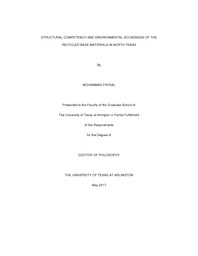| dc.description.abstract | Aggregates, which are derived from natural resources, are the most important raw materials used in pavement construction; however, depletion of the natural resources, increasing labor costs, and environmental concerns have led us to look for alternatives. Recycled materials, such as recycled crushed concrete aggregate (RCCA) and reclaimed asphalt pavement (RAP), can be used as an alternative to natural aggregates and can be obtained from construction of newer structures and demolition of existing structures, such as buildings, bridges, pavement, etc. Recycled materials can reduce the cost, depletion of natural resources, and construction debris. The properties of recycled materials are source-dependent, which limit their utility to a great extent. Considering these factors, this experimental program was designed to evaluate the strength, stiffness, durability, and environmental impacts of using recycled materials in the pavement base.
Different combinations of recycled crushed concrete aggregates (RCCA) and reclaimed asphalt pavement (RAP) aggregates, under cement-treated or untreated conditions, were utilized to evaluate the applicability of these available materials to a flexible pavement base layer. It was found that RAP materials are relatively weaker than the RCCA materials due to the asphalt coating on its surface, but RAP materials can be mixed with RCCA to increase strength. According to this study, RAP can be mixed with RCCA up to a ratio of 50/50, but it must be treated with 4% to 6% cement to fulfill the compressive strength requirement of 300 psi specified in the Texas Department of Transportation’s guidelines. The effect of the asphalt content on the strength and stiffness was also determined with the inclusion of additional asphalt to the RAP materials. Durability tests were performed with wetting and drying cycles on the weakest combinations of RCCA and RAP materials. These materials were found to be durable even after 30 wetting and drying cycles. Environmental tests were administered, such as pH, total and volatile dissolved solids, total and volatile suspended solids, turbidity, and chemical oxygen demand (COD). Test results were compared with the requirements of various environmental protection agencies and indicated that the recycled base materials are an environmentally-sound alternative to virgin aggregates and can be used in pavement bases or sub-base layers.
The most important stiffness parameter used in pavement design is resilient modulus; however, the resilient modulus test is too complicated and costly to perform on a regular basis. The unconfined compressive strength test is easier to administer. In this study, a multiple linear regression model was developed to determine the resilient modulus value from the parameters obtained from the unconfined compressive strength tests. It is believed that the statistical model can be useful in determining the stiffness parameter of cement-treated base materials. | |

